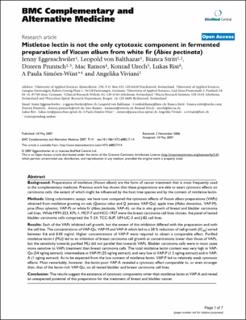Bitte benutzen Sie diese Kennung, um auf die Ressource zu verweisen:
https://doi.org/10.21256/zhaw-2771| Publikationstyp: | Beitrag in wissenschaftlicher Zeitschrift |
| Art der Begutachtung: | Peer review (Publikation) |
| Titel: | Mistletoe lectin is not the only cytotoxic component in fermented preparations of Viscum album from white fir (Abies pectinata) |
| Autor/-in: | Eggenschwiler, Jenny von Balthazar, Leopold Stritt, Bianca Pruntsch, Doreen Ramos, Mac Urech, Konrad Rist, Lukas Simões-Wüst, A Paula Viviani, Angelika |
| DOI: | 10.21256/zhaw-2771 10.1186/1472-6882-7-14 |
| Erschienen in: | BMC Complementary and Alternative Medicine |
| Band(Heft): | 7 |
| Heft: | 14 |
| Erscheinungsdatum: | 2007 |
| Verlag / Hrsg. Institution: | BioMed Central |
| ISSN: | 1472-6882 |
| Sprache: | Englisch |
| Schlagwörter: | Abies; Phytogenic antineoplastic agents; Breast neoplasms; Tumor cell line; Cell survival; Down-regulation; Urinary bladder neoplasms; Viscum album |
| Fachgebiet (DDC): | 616: Innere Medizin und Krankheiten |
| Zusammenfassung: | Background: Preparations of mistletoe (Viscum album) are the form of cancer treatment that is most frequently used in the complementary medicine. Previous work has shown that these preparations are able to exert cytotoxic effects on carcinoma cells, the extent of which might be influenced by the host tree species and by the content of mistletoe lectin. Methods: Using colorimetric assays, we have now compared the cytotoxic effects of Viscum album preparations (VAPs) obtained from mistletoe growing on oak (Quercus robur and Q. petraea, VAP-Qu), apple tree (Malus domestica,, VAP-M), pine (Pinus sylvestris, VAP-P) or white fir (Abies pectinata, VAP-A), on the in vitro growth of breast and bladder carcinoma cell lines. While MFM-223, KPL-1, MCF-7 and HCC-1937 were the breast carcinoma cell lines chosen, the panel of tested bladder carcinoma cells comprised the T-24, TCC-SUP, UM-UC-3 and J-82 cell lines. Results: Each of the VAPs inhibited cell growth, but the extent of this inhibition differed with the preparation and with the cell line. The concentrations of VAP-Qu, VAP-M and VAP-A which led to a 50 % reduction of cell growth (IC50) varied between 0.6 and 0.03 mg/ml. Higher concentrations of VAP-P were required to obtain a comparable effect. Purified mistletoe lectin I (MLI) led to an inhibition of breast carcinoma cell growth at concentrations lower than those of VAPs, but the sensitivity towards purified MLI did not parallel that towards VAPs. Bladder carcinoma cells were in most cases more sensitive to VAPs treatment than breast carcinoma cells. The total mistletoe lectin content was very high in VAP-Qu (54 ng/mg extract), intermediate in VAP-M (25 ng/mg extract), and very low in VAP-P (1.3 ng/mg extract) and in VAP-A (1 ng/mg extract). As to be expected from the low content of mistletoe lectin, VAP-P led to relatively weak cytotoxic effects. Most remarkably, however, the lectin-poor VAP-A revealed a cytotoxic effect comparable to, or even stronger than, that of the lectin-rich VAP-Qu, on all tested bladder and breast carcinoma cell lines. Conclusion: The results suggest the existence of cytotoxic components other than mistletoe lectin in VAP-A and reveal an unexpected potential of this preparation for the treatment of breast and bladder cancer. |
| URI: | https://digitalcollection.zhaw.ch/handle/11475/15012 |
| Volltext Version: | Publizierte Version |
| Lizenz (gemäss Verlagsvertrag): | CC BY 2.0: Namensnennung 2.0 Generic |
| Departement: | Life Sciences und Facility Management |
| Organisationseinheit: | Institut für Chemie und Biotechnologie (ICBT) |
| Enthalten in den Sammlungen: | Publikationen Life Sciences und Facility Management |
Dateien zu dieser Ressource:
| Datei | Beschreibung | Größe | Format | |
|---|---|---|---|---|
| 2007_Eggenschwiler_Mistletoe_lectin_BMC.pdf | 1.01 MB | Adobe PDF |  Öffnen/Anzeigen |
Zur Langanzeige
Eggenschwiler, J., von Balthazar, L., Stritt, B., Pruntsch, D., Ramos, M., Urech, K., Rist, L., Simões-Wüst, A. P., & Viviani, A. (2007). Mistletoe lectin is not the only cytotoxic component in fermented preparations of Viscum album from white fir (Abies pectinata). BMC Complementary and Alternative Medicine, 7(14). https://doi.org/10.21256/zhaw-2771
Eggenschwiler, J. et al. (2007) ‘Mistletoe lectin is not the only cytotoxic component in fermented preparations of Viscum album from white fir (Abies pectinata)’, BMC Complementary and Alternative Medicine, 7(14). Available at: https://doi.org/10.21256/zhaw-2771.
J. Eggenschwiler et al., “Mistletoe lectin is not the only cytotoxic component in fermented preparations of Viscum album from white fir (Abies pectinata),” BMC Complementary and Alternative Medicine, vol. 7, no. 14, 2007, doi: 10.21256/zhaw-2771.
EGGENSCHWILER, Jenny, Leopold VON BALTHAZAR, Bianca STRITT, Doreen PRUNTSCH, Mac RAMOS, Konrad URECH, Lukas RIST, A Paula SIMÕES-WÜST und Angelika VIVIANI, 2007. Mistletoe lectin is not the only cytotoxic component in fermented preparations of Viscum album from white fir (Abies pectinata). BMC Complementary and Alternative Medicine. 2007. Bd. 7, Nr. 14. DOI 10.21256/zhaw-2771
Eggenschwiler, Jenny, Leopold von Balthazar, Bianca Stritt, Doreen Pruntsch, Mac Ramos, Konrad Urech, Lukas Rist, A Paula Simões-Wüst, and Angelika Viviani. 2007. “Mistletoe Lectin Is Not the Only Cytotoxic Component in Fermented Preparations of Viscum Album from White Fir (Abies Pectinata).” BMC Complementary and Alternative Medicine 7 (14). https://doi.org/10.21256/zhaw-2771.
Eggenschwiler, Jenny, et al. “Mistletoe Lectin Is Not the Only Cytotoxic Component in Fermented Preparations of Viscum Album from White Fir (Abies Pectinata).” BMC Complementary and Alternative Medicine, vol. 7, no. 14, 2007, https://doi.org/10.21256/zhaw-2771.
Alle Ressourcen in diesem Repository sind urheberrechtlich geschützt, soweit nicht anderweitig angezeigt.